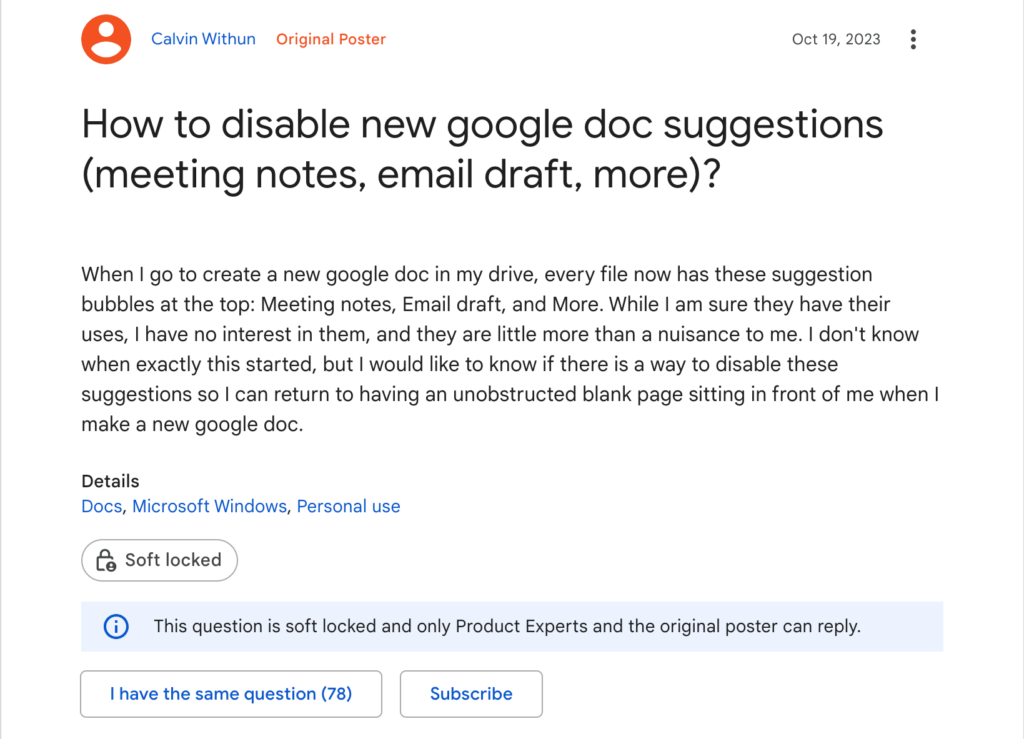I knew I was in trouble when I started googling answers and couldn’t find anything.
I had found myself getting really old-lady grumpy about seeing AI tools pop up in every single platform I use. Un-removable AI tools. Which I did not want, do not use, and find distracting, but which are now apparently welded into the rebar of the platform.
Then I started noticing how patronizing my tech was feeling. I’d sign into a google doc and it would try to present me with a number of different ways I could use it. My email started trying to tell me what to type, before I did the settings equivalent of shooting it in the face.
Everywhere I went, I was feeling forced into using my technology a certain way, based on decisions I had no control over, and features I hate.
I googled and googled and tried to find the answer to what this trend is. I didn’t find any answers, but I did find a whole lot of people just as annoyed as I am.
Which got me thinking about hammers.
The first hammers were used about 3.3 million years ago. They got their handles about 30,000 years ago. And the basic shape has stayed the same ever since.
You can use a hammer to build a house. You can use a hammer to take a box apart. You can use a hammer to cave someone’s skull in. You can use a hammer to tenderize a steak before you cook it. If you also have a chopstick or table knife, you can use a hammer to open a bottle of wine.
That’s what tools are.
They’re objects you use to accomplish a goal.
Note the word order there, it’s important.
You
Use
The object.
You are the one doing the using. It is there to be used. It is not there to, say, replace you. To act as a sentient partner to you. To try to guess what you were going to do based on the aggregated data of what a bunch of other people did.
Instead, what we’re seeing is a shift in which tools try to tell you how to use them — and are, in fact, created in ways that specifically limit and dictate your use of them.
Here’s how I think we got here:
We started with a work atmosphere in which customers have become largely ancillary in business.
Modern business is about customers in the same way that pro wrestling kayfabe was totally absolutely real, wink wink nudge nudge. Also like wrestling, it used to be more closely tied to what it was ostensibly about. Wrestlers actually used to fight, business used to have more of a focus on customers. But as we’re experiencing the fallout of 40 years of shareholder supremacy, customers aren’t customers anymore. They’re resources. You and I and the people who buy things from companies aren’t real people. We’re data on a spreadsheet. People are people. Customers are a resource. And while we’re still all kinda trying to keep that kayfabe going and say that business is at least somewhat about serving customers, the truth is, we haven’t been playing that game in a long time.
There’s a million examples of this, but for one more relevant to this post, look at what’s driving all these frantic AI rollouts. They’re not driven by a market that’s clamoring for AI. ChatGPT had incredibly fast adoption rates, but they’re already starting to drop steadily. There’s no massive market desire driving these rollouts — it’s fear of missing a trend on the part of the companies, combined with what I suspect is a not-so-secret desire on the part of CEOs to be able to pull an iPhone, giving the market what it didn’t know it needed. Again, not about the customers.
Which then led to a race to the boring middle.
If you don’t have to deal with actual people as people, then all the sudden you don’t have to think about providing them with something that’s useful for their unique purposes or expression. You just have to find a median that serves enough of your market, and then cater to that. It’s not about making a tool for people to use, it’s about extracting the maximum amount of resources from that particular well (in this case, customers).
That’s why we’re now seeing this shift from “Here are some tools or features, use them as you will” to “Somebody might want it, so everyone must have it!”
Enter: my other grand annoyance, the little boxes at the top of google docs. I know they can be very helpful to some people. But I hate them. As do many others.
And you know what? You could make a little tick box that we could click, and they could go away, and look at that, everybody’s happy. This is how software tools have worked for quite some time. It’s also why some of the most popular ones right now — for instance, Notion — have such intense followings. Because they’re basically Legos, you can do whatever you want with them.
This shift into straightjacketed tools is a symbol of a race to the boring middle: if we can find what we think the largest segment might need, then we can just force that on everyone. Instead of providing tools that let people use them as they will, we’re seeing a shift into companies guessing what people want (or listening to whatever tech company has the snazziest pitch deck about what customers, like, totally want, for serious), and dumbing down their functionality to the median of an aggregate.
It’s a race to the boring grey middle, a shapeless aggregate watered down from the millions upon millions of decisions people have made. As User 5491277226974517036 beautifully phrased it in that google support forum about those damn boxes, it’s coerced mediocrity.
Now, how could we get to coerced mediocrity, particularly from an industry that’s ostensibly so focused on innovation and creativity? Our old friend behaviorism.
Behaviorism, put very simply, is a belief that humans are ultimately just very fancy machines. All our behavior can be traced back to logical triggers, and while we’re too dumb to understand the forces acting upon us, we are but doggos in Pavlov’s lab. (If you saw the article about how free will is for-sure an illusion making the rounds, that stems from a behaviorist worldview.)
Now, if behaviorism is right, and we are just fancy machines, than all these tools are great! They’re the equivalent of our go go Gadget arms*, amplifying our inherent machine-like capabilities. And, what’s more, in a behaviorist worldview I’m naturally open to influence. If I’m just a machine, then of course logically I would want my good friends at XYZ company to tell me the optimal way to use their software, because that’s what I’m here for, to optimize.
The problem is, behaviorism is at its very best an incomplete understanding of how humans work.
Is conditioning a thing? Are we influenced by the world around us? Does every single decision make it onto the dashboard of the pre-frontal cortex? Yes, yes, and of course not. The role of the gut biome in the gut-brain-skin axis alone puts paid to that idea. But to completely buy into behaviorism and pretend we’re all just very fancy robots is a fundamental misunderstanding of how humans work.
We create. We decide. We have will.
We are, in fact, as far as we can tell, the only animals that can shape our own sandbox. Which means that I might want an AI go go Gadget arm upgrade. Or I might not. I might do something with it it’s not programed for. Or I might ignore it entirely. I can do that, because I’m a human, and I decide.
And I think that’s what this is ultimately all about: the formation of a system grounded in a behaviorist worldview and predicated on the idea that your technology knows what you need better than you do.
This is never going to be true. You know what you need. And you deserve tools that are just that: tools. Useful. Not patronizing. Not pre-determined.
And yes, I’ve read the arguments that say “Well, AI is only annoying and shitty right now because it’s new. It’s still learning, It’ll get seamless and invisible as we go. Just because chatbots have a 75%+ rate of failure and everyone hates them doesn’t mean they’re bad!!”
That’s missing the point. Machines by their nature are incapable of the creativity of humanity because they have no will. They’re tools. They’re SUPER useful tools. But they’re meant to be used. As tools. Not as substitutes or partners.
Tools that attempt to replace the uniquely human elements of creativity, surprise, and a priori acts of the will are doomed to failure.
And in the meantime they’ll just annoy the shit out of us.
Now pardon me while I go X out yet another pop up begging me to sign up for some “magic” AI tool.
*Thanks Dr JMac for the analogy!

